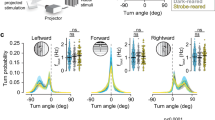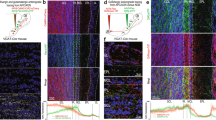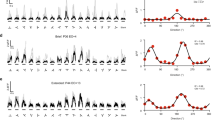Abstract
During the development of sensory systems, receptive fields are modified by stimuli in the environment. This is thought to rely on learning algorithms that are sensitive to correlations in spike timing between cells, but the manner in which developing circuits selectively exploit correlations that are related to sensory inputs is unknown. We recorded from neurons in the developing optic tectum of Xenopus laevis and found that repeated presentation of moving visual stimuli induced receptive field changes that reflected the properties of the stimuli and that this form of learning was disrupted when GABAergic transmission was blocked. Consistent with a role for spike timing–dependent mechanisms, GABA blockade altered spike-timing patterns in the tectum and increased correlations between cells that would affect plasticity at intratectal synapses. This is a previously unknown role for GABAergic signals in development and highlights the importance of regulating the statistics of spiking activity for learning.
This is a preview of subscription content, access via your institution
Access options
Subscribe to this journal
Receive 12 print issues and online access
$209.00 per year
only $17.42 per issue
Buy this article
- Purchase on Springer Link
- Instant access to full article PDF
Prices may be subject to local taxes which are calculated during checkout








Similar content being viewed by others
References
Goodman, C.S. & Shatz, C.J. Developmental mechanisms that generate precise patterns of neuronal connectivity. Cell 72, 77–98 (1993).
Katz, L.C. & Shatz, C.J. Synaptic activity and the construction of cortical circuits. Science 274, 1133–1138 (1996).
Wiesel, T.N. & Hubel, D.H. Single-cell responses in striate cortex of kittens deprived of vision in one eye. J. Neurophysiol. 26, 1003–1017 (1963).
Stryker, M.P. Evidence for a possible role for spontaneous electrical activity in the development of the mammalian visual cortex. in Problems and Concepts in Developmental Neurophysiology (eds. Kellaway, P. & Noebels, J.L.) 110–130 (John Hopkins University Press, Baltimore, 1989).
Weliky, M. & Katz, L.C. Disruption of orientation tuning in visual cortex by artificially correlated neuronal activity. Nature 386, 680–685 (1997).
Engert, F., Tao, H.W., Zhang, L.I. & Poo, M. Moving visual stimuli rapidly induce direction sensitivity of developing tectal neurons. Nature 419, 470–475 (2002).
Li, Y., Van Hooser, S.D., Mazurek, M., White, L.E. & Fitzpatrick, D. Experience with moving visual stimuli drives the early development of cortical direction selectivity. Nature 456, 952–956 (2008).
Meliza, C.D. & Dan, Y. Receptive-field modification in rat visual cortex induced by paired visual stimulation and single-cell spiking. Neuron 49, 183–189 (2006).
Sengpiel, F., Stawinski, P. & Bonhoeffer, T. Influence of experience on orientation maps in cat visual cortex. Nat. Neurosci. 2, 727–732 (1999).
Vislay-Meltzer, R.L., Kampff, A.R. & Engert, F. Spatiotemporal specificity of neuronal activity directs the modification of receptive fields in the developing retinotectal system. Neuron 50, 101–114 (2006).
Mu, Y. & Poo, M. Spike timing–dependent LTP/LTD mediates visual experience–dependent plasticity in a developing retinotectal system. Neuron 50, 115–125 (2006).
Schuett, S., Bonhoeffer, T. & Hübener, M. Pairing-induced changes of orientation maps in cat visual cortex. Neuron 32, 325–337 (2001).
Shon, A.P., Rao, R.P.N. & Sejnowski, T.J. Motion detection and prediction through spike-timing dependent plasticity. Network 15, 179–198 (2004).
Wenisch, O.G., Noll, J. & Hemmen, J. Spontaneously emerging direction selectivity maps in visual cortex through STDP. Biol. Cybern. 93, 239–247 (2005).
Weliky, M. Correlated neuronal activity and visual cortical development. Neuron 27, 427–430 (2000).
Ramoa, A.S., Paradiso, M.A. & Freeman, R.D. Blockade of intracortical inhibition in kitten striate cortex: effects on receptive field properties and associated loss of ocular dominance plasticity. Exp. Brain Res. 73, 285–296 (1988).
Gabernet, L., Jadhav, S.P., Feldman, D.E., Carandini, M. & Scanziani, M. Somatosensory integration controlled by dynamic thalamocortical feed-forward inhibition. Neuron 48, 315–327 (2005).
Pouille, F. & Scanziani, M. Enforcement of temporal fidelity in pyramidal cells by somatic feedforward inhibition. Science 293, 1159–1163 (2001).
Wehr, M. & Zador, A.M. Balanced inhibition underlies tuning and sharpens spike timing in auditory cortex. Nature 426, 442–446 (2003).
Cobb, S.R., Buhl, E.H., Halasy, K., Paulsen, O. & Somogyi, P. Synchronization of neuronal activity in hippocampus by individual GABAergic interneurons. Nature 378, 75–78 (1995).
Akerman, C.J. & Cline, H.T. Depolarizing GABAergic conductances regulate the balance of excitation to inhibition in the developing retinotectal circuit in vivo. J. Neurosci. 26, 5117–5130 (2006).
Dunning, D.D., Hoover, C.L., Soltesz, I., Smith, M.A. & O′Dowd, D.K. GABAA receptor–mediated miniature postsynaptic currents and alpha-subunit expression in developing cortical neurons. J. Neurophysiol. 82, 3286–3297 (1999).
Hollrigel, G.S. & Soltesz, I. Slow kinetics of miniature IPSCs during early postnatal development in granule cells of the dentate gyrus. J. Neurosci. 17, 5119–5128 (1997).
Liu, Y., Zhang, L.I. & Tao, H.W. Heterosynaptic scaling of developing GABAergic synapses: dependence on glutamatergic input and developmental stage. J. Neurosci. 27, 5301–5312 (2007).
Tao, H.W. & Poo, M. Activity-dependent matching of excitatory and inhibitory inputs during refinement of visual receptive fields. Neuron 45, 829–836 (2005).
Tyzio, R. et al. The establishment of GABAergic and glutamatergic synapses on CA1 pyramidal neurons is sequential and correlates with the development of the apical dendrite. J. Neurosci. 19, 10372–10382 (1999).
Luhmann, H.J. & Prince, D.A. Postnatal maturation of the GABAergic system in rat neocortex. J. Neurophysiol. 65, 247–263 (1991).
Mueller, A.L., Taube, J.S. & Schwartzkroin, P.A. Development of hyperpolarizing inhibitory postsynaptic potentials and hyperpolarizing response to gamma-aminobutyric acid in rabbit hippocampus studied in vitro. J. Neurosci. 4, 860–867 (1984).
Zhang, L.I., Tao, H.W. & Poo, M. Visual input induces long-term potentiation of developing retinotectal synapses. Nat. Neurosci. 3, 708–715 (2000).
Zhang, L.I., Tao, H.W., Holt, C.E., Harris, W.A. & Poo, M. A critical window for cooperation and competition among developing retinotectal synapses. Nature 395, 37–44 (1998).
Gao, X.B. & Van Den Pol, A.N. GABA, not glutamate, a primary transmitter driving action potentials in developing hypothalamic neurons. J. Neurophysiol. 85, 425–434 (2001).
Staley, K.J. & Mody, I. Shunting of excitatory input to dentate gyrus granule cells by a depolarizing GABAA receptor–mediated postsynaptic conductance. J. Neurophysiol. 68, 197–212 (1992).
Ulrich, D. Differential arithmetic of shunting inhibition for voltage and spike rate in neocortical pyramidal cells. Eur. J. Neurosci. 18, 2159–2165 (2003).
Gulledge, A.T. & Stuart, G.J. Excitatory actions of GABA in the cortex. Neuron 37, 299–309 (2003).
Chen, G., Trombley, P.Q. & van den Pol, A.N. Excitatory actions of GABA in developing rat hypothalamic neurones. J. Physiol. (Lond.) 494, 451–464 (1996).
Pratt, K.G., Dong, W. & Aizenman, C.D. Development and spike timing–dependent plasticity of recurrent excitation in the Xenopus optic tectum. Nat. Neurosci. 11, 467–475 (2008).
Holt, C.E. & Harris, W.A. Order in the initial retinotectal map in Xenopus: a new technique for labeling growing nerve fibres. Nature 301, 150–152 (1983).
Froemke, R.C. & Dan, Y. Spike timing–dependent synaptic modification induced by natural spike trains. Nature 416, 433–438 (2002).
Sjöström, P.J., Turrigiano, G.G. & Nelson, S.B. Rate, timing and cooperativity jointly determine cortical synaptic plasticity. Neuron 32, 1149–1164 (2001).
Wulff, P. et al. Synaptic inhibition of Purkinje cells mediates consolidation of vestibulo-cerebellar motor learning. Nat. Neurosci. 12, 1042–1049 (2009).
Akerman, C.J. & Cline, H.T. Refining the roles of GABAergic signaling during neural circuit formation. Trends Neurosci. 30, 382–389 (2007).
Pavlov, I., Riekki, R. & Taira, T. Synergistic action of GABAA and NMDA receptors in the induction of long-term depression in glutamatergic synapses in the newborn rat hippocampus. Eur. J. Neurosci. 20, 3019–3026 (2004).
Wang, D.D. & Kriegstein, A.R. GABA regulates excitatory synapse formation in the neocortex via NMDA receptor activation. J. Neurosci. 28, 5547–5558 (2008).
Hensch, T.K. et al. Local GABA circuit control of experience-dependent plasticity in developing visual cortex. Science 282, 1504–1508 (1998).
Nieuwkoop, P.D. & Faber, J. Normal Table of Xenopus laevis (Daudin): A Systematical and Chronological Survey of the Development from the Fertilized Egg till the End of Metamorphosis (North-Holland Pub., Amsterdam, 1967).
Khawaled, R., Bruening-Wright, A., Adelman, J.P. & Maylie, J. Bicuculline block of small-conductance calcium-activated potassium channels. Pflugers Arch. 438, 314–321 (1999).
Niell, C.M. & Smith, S.J. Functional imaging reveals rapid development of visual response properties in the zebrafish tectum. Neuron 45, 941–951 (2005).
Dayan, P. & Abbott, L.F. Neural encoding I: firing rates and spike statistics. in Theoretical Neuroscience: Computational and Mathematical Modeling of Neural Systems (eds. Sejnowski, T.J. & Poggio, T.) 3–44 (MIT Press, Cambridge, Massachusetts, 2003).
Song, S., Miller, K.D. & Abbott, L.F. Competitive Hebbian learning through spike timing–dependent synaptic plasticity. Nat. Neurosci. 3, 919–926 (2000).
Tao, H.W., Zhang, L.I., Engert, F. & Poo, M. Emergence of input specificity of LTP during development of retinotectal connections in vivo. Neuron 31, 569–580 (2001).
Acknowledgements
We would like to thank H. Cline, K. Lamsa and O. Paulsen for helpful discussions and for comments on the manuscript. This work was supported by grants from the Biotechnology and Biological Sciences Research Council (BB/E0154761) and the Medical Research Council (G0601503). The research leading to these results has received funding from the European Research Council under the European Community's Seventh Framework Programme (FP7/2007-2013), ERC grant agreement number 243273. In addition, C.J.A. was supported by a Fellowship from the Research Councils UK and British Pharmacological Society, and B.A.R. was supported by a Wellcome Trust Doctoral Fellowship and a Post Graduate Scholarship from the Natural Sciences and Engineering Research Council of Canada.
Author information
Authors and Affiliations
Contributions
B.A.R. conducted the experiments. B.A.R., O.P.V. and C.J.A. designed the experiments, contributed to the data analysis, prepared the figures and wrote the manuscript.
Corresponding author
Ethics declarations
Competing interests
The authors declare no competing financial interests.
Supplementary information
Supplementary Text and Figures
Supplementary Figures 1–7 (PDF 965 kb)
Rights and permissions
About this article
Cite this article
Richards, B., Voss, O. & Akerman, C. GABAergic circuits control stimulus-instructed receptive field development in the optic tectum. Nat Neurosci 13, 1098–1106 (2010). https://doi.org/10.1038/nn.2612
Received:
Accepted:
Published:
Issue Date:
DOI: https://doi.org/10.1038/nn.2612



